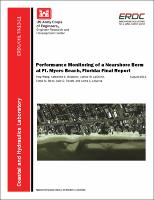Please use this identifier to cite or link to this item:
https://hdl.handle.net/11681/7338| Title: | Performance monitoring of a nearshore berm at Ft. Myers Beach, Florida : final report |
| Authors: | Wang, Ping Brutsche, Katherine E. LaGrone, James W. Beck, Tanya M. Rosati, Julie Dean Lillycrop, Linda S. |
| Keywords: | Navigation Channels Navigation channels Dredging Dredge Material placement Dredged materials Nearshore berm Coastal processes Sediment transport Sedimentation Deposition Coastal Inlets Research Program (U.S.) Regional Sediment Management Program (U.S.) |
| Publisher: | Engineer Research and Development Center (U.S.) |
| Series/Report no.: | Technical report (Engineer Research and Development Center (U.S.)) ; no.ERDC/CHL TR-13-11 |
| Abstract: | This report documents the placement and monitoring of an active nearshore berm at Ft. Myers Beach, Florida. From May to July 2009, mixed sand and finer sediment dredged from a nearby inlet was were placed in the active littoral zone in the form of a bar-shaped nearshore berm. Six sets of beach-nearshore profile surveys and two periods of sediment sampling along profiles were collected. The Ft. Myers Beach nearshore berm migrated onshore roughly 300 ft during the first two years. The elevation of the berm crest increased up to 2.0 ft. Nearly half of the onshore migration occurred during the first nine months post-construction. Greater distances of onshore migration were measured during the more energetic winter seasons than during calmer summer seasons. No offshore migration was measured during the entire two-year study period. The shape of the nearshore berm evolved from a roughly symmetrical bell-shaped bar to a highly asymmetrical shape with a steep landward slope, typical of a landward migrating bar. At the end of the two-year period, the berm migrated to roughly 150 to 200 ft from mean sea level shoreline. The dry beach landward of the berm and along the adjacent beaches remained stable over the two-year period. A primary concern of this project was the dispersion of fine sediment following placement. Results of sediment sampling indicated that some of the fine material initially migrated into the nearshore trough, and was then dispersed further offshore after several months. Onshore-directed transport and deposition of coarser sand fractions, and offshore-directed transport and deposition of fine fractions were observed. The nearshore berm had negligible influence on the characteristics of the dry beach sediment, which remained to be well- sorted, fine sand. The constructed berm showed considerable longshore variation in morphology, including several gaps/depressions. These gaps were maintained over the two-year period, although longshore and cross-shore migrations were measured. Future studies should include continued monitoring to document potential attachment of the nearshore berm to the dry beach. |
| Description: | Technical Report |
| Gov't Doc #: | ERDC/CHL TR-13-11 |
| Rights: | Approved for public release; distribution is unlimited |
| URI: | http://hdl.handle.net/11681/7338 |
| Appears in Collections: | Technical Report Technical Report |
Files in This Item:
| File | Description | Size | Format | |
|---|---|---|---|---|
| ERDC-CHL-TR-13-11.pdf | ERDC/CHL TR-13-11 | 32.77 MB | Adobe PDF |  View/Open |